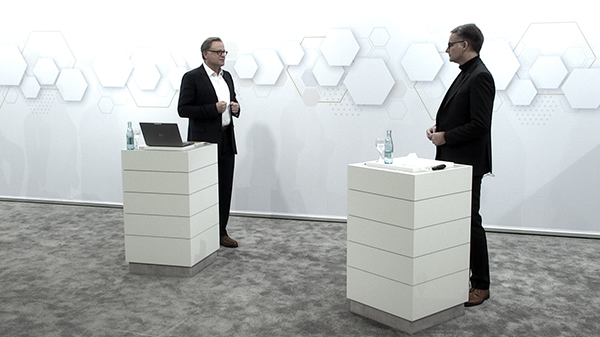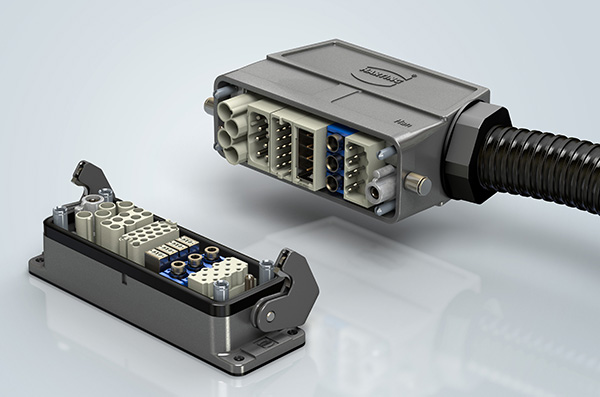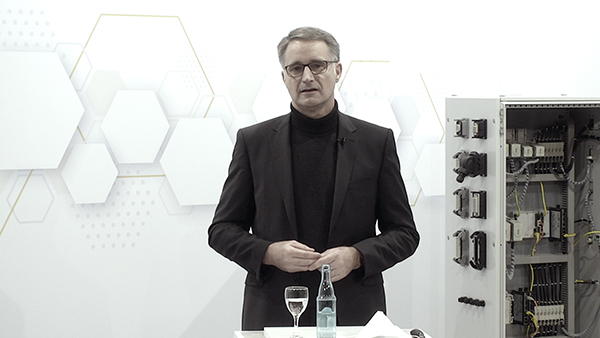
|
Prepared for the next round of digitalizationAn interview with Dr. Kurt D. Bettenhausen The HARTING Technology Group, one of the world's leading suppliers of connection technology, made use of PROSTEP's PLM strategy consulting services last year. In this interview, Dr. Kurt D. Bettenhausen, member of the board responsible for New Technologies and Development at HARTING, discusses the company's digitalization strategy and the need for action in product development. 
Question: Dr. Bettenhausen, could you give us a brief introduction to HARTING? Bettenhausen: HARTING is a leading global provider of connectivity solutions for the transmission of data, signals and energy in automation technology, mechanical engineering, robotics and, particularly important, in railway technology. We also supply entire checkout zones and provide the automotive engineering sector with actuators, magnet systems, etc. Our big growth market there is power transmission for electric vehicles with on-board charging cables, as well as charging cables and connectivity solutions for charging stations. We are a tier-1 supplier to the VW Group, supplying for example a cooled fast charging solution for the Porsche Taycan. Question: HARTING has successfully defied the coronavirus pandemic and saw a slight increase in revenue last year. What factors played a role in this success? Bettenhausen: First of all, close proximity to customers and to the markets and responding quickly to their requirements. The second factor is a strong sense of responsibility. We have ensured that our employees can work safely, be it in the office, on the production floor, in the testing laboratories or in logistics, and thus maintained our ability to deliver at any time. The third factor is that we quickly adapted all our market communications. Question: In which industries and markets are you experiencing the greatest growth? Bettenhausen: One area is undoubtedly electromobility, which really took off in Germany last year, thanks in part to financial support measures. This is where we recorded the highest rates of growth percentage-wise. But we have also enjoyed growth in the fields transportation/railway technology, automation and logistics. The fact that we are able to grow in a time when many companies are shrinking means that everyone has made a contribution. Question: You recently established a cooperation with MIT. What kind of impetus do you hope this will provide? Bettenhausen: We hope to find partners for collaboration and co-creation. MIT is one of the top addresses worldwide when it comes to thinking outside the box. With its hardware sector, the ecosystem in the northeast of the USA is a deliberate counter-pole to Silicon Valley. Companies that are part of this ecosystem via the Industrial Liaison Program are able to come together more quickly with the aim of solving tasks or developing initial prototypes. Question: How innovative is HARTING? How "young" are your products on average? Bettenhausen: We have a large number of new products in every sector. But we also continue to develop the products that our customers have known and valued for years. Countless variants of HARTING's HAN connector, which we patented at the end of the 1950s, are still available today. It is constantly being expanded to include new modules, such as ID modules and current sensors, and new power ratings. Question: What challenges does HARTING face in product development? How global is your product development? Bettenhausen: We have globally distributed teams to ensure that we drive development forward close to and together with our customers, even though development is still primarily carried out in Germany. This means making note of customer requirements in a quick exchange and developing innovative answers ourselves. Question: Aren't connectors standard products? Bettenhausen: We cover a whole range of connectors. The basis is provided by standard connectors from the catalog. They have a modular concept and you can configure them to meet your requirements. Then there is the Customized Solutions division, where we develop complete solutions together with customers. The jumper cables between two railcars are a good example. Every railcar manufacturer has its preferences as to what it wants to exchange and how it wants to exchange data, signals and power. Question: What does this wide range of products mean in terms of your digitalization strategy? Bettenhausen: It has to offer an appropriate level of flexibility. An off-the-shelf digitalization solution only offers us help with our standard products – we need flexibility for everything else. It begins with our colleagues, who first have to understand the task for which they are supposed to provide a solution together with the customer. PLM tools that offer a corresponding level of flexibility are needed to plan and produce this solution. 
Question: In which fields of activity are you driving digitalization forward? Bettenhausen: If you want to produce a modular HAN connector down to a batch size of 1, all the processes from ordering to production through to logistics have to be digitalized systematically. This is why we keep a close eye on everything to do with enterprise software. Here at HARTING, we don't realize a project and then leave it as it is for all eternity. It's like the lathes we were introduced to in the apprentice workshop but no longer use. The same applies to digitalization: We use it, develop it further and launch the next stage whenever it makes sense and is needed. Question: And what about digitalization in the context of product development? Bettenhausen: Digitalization of product development alone won't help if we can't get our products out there. That's why we have an outstanding mechanical engineering department that can perform certain special tasks in-house. Product development has come a long way over the last ten years. The big players in the PLM sector have come out with complete solutions that can be used to simulate the mechanical, electrical and thermal properties of the products to be designed and break the digital twin down to the levels required by production. Question: What role does PLM play in your digitalization strategy? Bettenhausen: We think in terms of three core processes: development, production and sales. Development includes all the steps from designing the products to designing the production systems to making the resulting product data available throughout the entire value-added chain. Question: What does your PLM landscape currently look like? What are the cornerstones? Bettenhausen: The cornerstones are currently management of master data and the 3D drawing chain. The aim now is to take the next step with an upcoming PLM project. Question: Am I right in assuming that you don't want to reveal which systems you are currently using? 
Bettenhausen: Yes. However, I can tell you that we are using two of the leading products for PLM and ERP. Question: If you are using two leading systems, why did you need PROSTEP's PLM strategy consulting services? Bettenhausen: We wanted to prepare for the next round and not, so to speak, "stew in our own juices" and be dependent on the information provided by the vendors. A PLM project is about the processes, the organization and only at the end about the tools. When it came to preparing for the project, it was important that we get an opinion from a largely neutral third party and see whether our own assessment was right. PROSTEP was a big help. The consulting took place before I joined the company. I only joined in time to see the presentation of the results and thought it a great success. An appropriate roadmap had been drawn up indicating how we can further develop three interwoven aspects, namely processes, organization and tools, in the coming years. Question: In which processes is there a need for action? Bettenhausen: A review of the current distribution of tasks in the core process development indicated that we need to develop it further. This was confirmed by our own assessment. Question: Can you say specifically what you want to develop further? Bettenhausen: Collaboration between the different disciplines.... Question: Do you mean mechatronics and system development? You want to achieve a more integrated development process? Bettenhausen: We want to add new functionality to the electromechanical design process and integrate the various disciplines involved more tightly into it. In a further step, we want to integrate simulations into the design process rather than carrying them out in parallel with the design. Question: You are the chairman of the VDI's Digital Transformation Committee. What does transformation mean for HARTING? Or to put it another way, are you still digitalizing or are you already transforming? Bettenhausen: I use the term "digitalization" to refer to the availability of data and information in digital form. We at HARTING have already come a long way in this respect. The next step is to see whether we can do the same with our processes and our organization and as highly efficiently as we intend. That is the aspect of transformation that we are currently working on. Mr. Bettenhausen, thank you very much for talking to us.
Dr. Kurt D. Bettenhausen has been the member of the board responsible for New Technologies and Development at the HARTING Technology Group since September 2020. Prior to this, he was Chief Technology Officer at Schunk, a manufacturer of gripping systems and clamping technology. Bettenhausen studied electrical engineering at the Technical University of Darmstadt, where he also completed his doctorate. He then gained his first job experience at Hoechst AG, parts of which were taken over by Siemens in 2001. Bettenhausen worked for Siemens for over 17 years in a number of different management positions, his last as Senior Vice President of Siemens Corporation in the USA. |
|
| © PROSTEP AG | ALL RIGHTS RESERVED | IMPRINT | PRIVACY STATEMENT | YOU CAN UNSUBSCRIBE TO THE NEWSLETTER HERE. |
